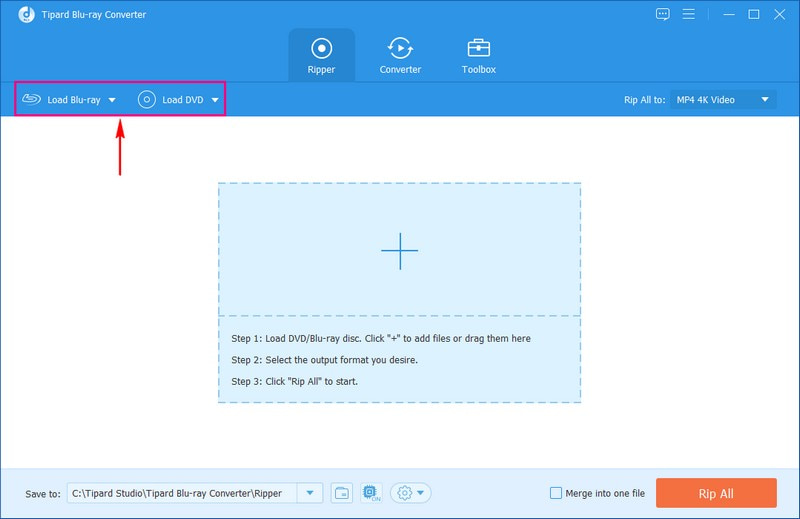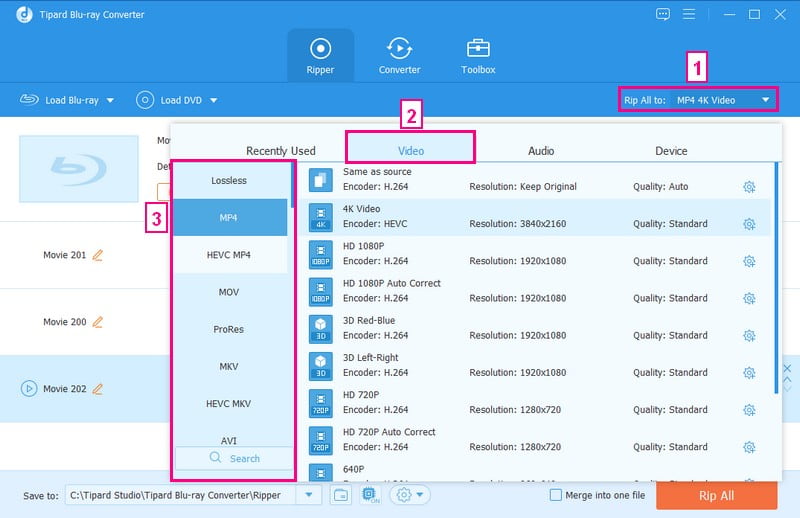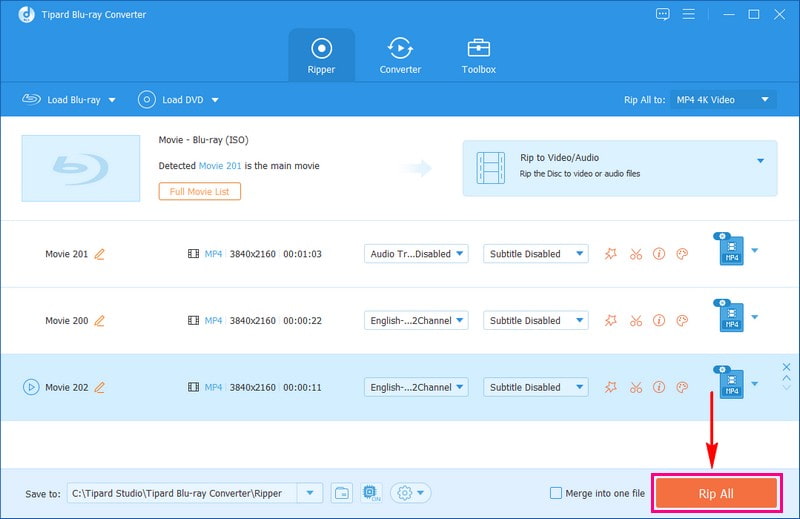Blu-ray and HD DVDs are two special discs with high-quality videos. They are like the next level up for watching super-high-definition movies. This write-up will dive into a comparison between Blu-ray vs. HD DVD. We will talk about how they are different from each other. In addition, we will check out a valuable way to turn these discs into digital files using a top-notch program. Therefore, you can keep enjoying your favorite movies even if you do not have a Blu-ray or HD DVD player handy.
Part 1. In-Depth Comparison of Blu-ray & HD DVD
In comparing Blu-ray vs. HD DVD, we will dig deeper into the differences between these high-definition optical disc formats. This exploration will highlight their definition, storage capacity, history, price, video and audio quality, and more.
Definition
◆ Blu-ray: Blu-ray is a newer optical disc format developed in the early 2000s. It uses blue-violet laser technology to store and read data, allowing for higher storage capacity and better resolution than DVDs.
◆ HD DVD: It is short for High Density Digital Versatile Disc, which supports for high-definition playback. Developed by Toshiba, HD DVD can be seen as the successor to the standard DVD format and a competitor to Blu-ray.
Capacity
◆ Blu-ray: Offers significantly more storage, storing 25 to 50 GB on a single-layer disc and up to 100 GB on a dual-layer disc. This larger capacity allows for high-definition (HD) and ultra-high-definition (UHD) content.
◆ HD DVD: Typically stores 15 GB of data on a single-layer disc and up to 30 GB on a dual-layer disc.
History
◆ Blu-ray: Blu-ray emerged as a successor to DVDs, aiming to meet the demand for higher quality and greater storage capacities.
◆ HD DVD: HD DVD was release by Toshiba on March 31, 2006. However, because of its rival Blu-ray, HD DVD met its dissolution on March 28, 2008.
Price
◆ Blu-ray: Slightly more expensive due to their advanced technology and higher storage capacity.
◆ HD DVD: Generally cheaper than Blu-ray discs. However, its dissolution makes it worth less.
Video & Audio Quality
◆ Blu-ray: Provides significantly enhanced video quality, supporting high-definition resolutions like 1080p or even 4K (Ultra HD). It also offers superior audio formats like Dolby TrueHD and DTS-HD Master Audio, delivering immersive sound experiences.
◆ HD DVD: Support a wide variety of resolutions: 720p, 1080i and 1080p. It offers Dolby Digital or DTS sound.
Advantages
◆ Blu-ray: Offers higher storage capacity for HD and UHD content, superior audio and video quality, and enhances features like interactive menus and advanced subtitles.
◆ HD DVD: It is widely supported by global industry giants, including Intel, Toshiba, Samsung, Microsoft, Hitachi, Fujitsu, etc.
Disadvantages
◆ Blu-ray: It is more expensive than DVDs, and not all older devices support Blu-ray.
◆ HD DVD: It has limited gaming support. The game is not yet available in HD DVD format. For game support, the Microsoft Xbox 360 Add-on is required.
By reading and comparing the above, you can see that the relationship between Blu-ray vs. HD DVD is competitive. As the winner of the format war, Blu-ray defeated HD DVD because of its more advanced privacy protections, higher capacity, and better audio quality.
Part 2. How to Convert Blu-ray/HD DVD to Digital
Are you looking to convert your Blu-ray or HD DVD collection into digital files for easy access? Enter Tipard Blu-ray Converter! This nifty program is designed to make the conversion process smooth and hassle-free. You can convert your Blu-ray or HD DVD content into popular digital formats like MP4, MKV, AVI, and more. This flexibility lets you select the format that suits your needs or device compatibility.
- It maintains the high-definition goodness of your Blu-ray or HD DVD content.
- It supports most popular digital video formats.
- Its speedy conversions can save your time.
- It allows you to edit and customize movies.
Step 1Download and Install the Tipard Blu-ray Converter on your computer. Once installed, launch the program.

TRY IT FREE For Windows 7 or later
 Secure Download
Secure Download
TRY IT FREE For Mac OS X 10.13 or later
 Secure Download
Secure DownloadStep 2Insert the Blu-ray or HD DVD into your computer's disc drive. In Tipard Blu-ray Converter, click the Load Blu-ray or Load DVD drop-down menu and pick your importing section. The program will detect and load the contents of the disc.

Step 3Choose Main Title or Full Title List to present the content on the Blu-ray. After the disc is loaded, choose the output format for the digital conversion. This program supports various video and audio formats.
Hit the Rip All to drop-down menu to select the desired format; common formats include MP4, MKV, AVI, etc.

Step 4You can also personalize the output settings according to your preferences. Modify the parameters like video resolution, bitrate, audio settings, etc. To access these settings, click the Cogwheel button next to the chosen output format. Once settled, hit the Create New button to apply the changes.

Step 5Pick the destination folder where you want the converted digital file to be saved. Tick on the Browse button to choose the output path on your computer.
Once all settings are adjusted and the output folder is selected, click the Rip All button to begin the conversion process. Tipard Blu-ray Converter will start converting your content into the selected digital format. You can track the conversion progress in real-time through the progress bar displayed in the software's interface.

Once the conversion is complete, Tipard Blu-ray Converter will notify you. You can now access the digital file in the output folder you previously selected.
Part 3. FAQs About Blu-ray vs. HD DVD
Are Blu-rays region-free like DVDs?
Unlike DVDs, Blu-rays have region codes that limit where they can be played. But there are Blu-ray players that ignore these limits, and some discs work worldwide or in multiple Blu-ray regions.
Is there a noticeable difference in quality between Blu-ray and HD DVD?
Both Blu-ray and HD DVD provide top-notch video and sound in high definition. However, Blu-ray usually edges ahead with slightly better quality because of their varying capacities and tech.
Can Blu-ray players play regular DVDs?
Yes! Many Blu-ray players can play regular DVDs. They have a feature that enhances how DVDs look on high-definition TVs, making them more precise and better to watch.
Are Blu-ray players compatible with HD DVDs?
Usually, Blu-ray players cannot handle HD DVDs because they are made differently, using various laser tech and disc structures. Yet, a few rare players managed both formats, but they are rare.
Are Blu-ray discs still relevant with the rise of streaming services?
Even though streaming is popular, Blu-ray discs remain essential for fans who want top-notch audio and video. They are great for collectors who like physical copies and deliver the finest quality, especially those with fancy home theater setups.
After diving into the intricacies of Blu-ray disc vs. HD DVD, it is clear that each has its strengths. However, with the transition toward digital accessibility, converting your collection becomes essential. That is where the Tipard Blu-ray Converter shines!
Tipard Blu-ray Converter is your go-to solution to transform your Blu-ray or HD DVD collection into digital formats. This program simplifies the process, ensuring you retain the high-definition quality of your movies while granting flexibility for playback on various devices.
Full-featured multimedia player to play Blu-rays, DVDs, 4K UHDs, and other video/audio files.




